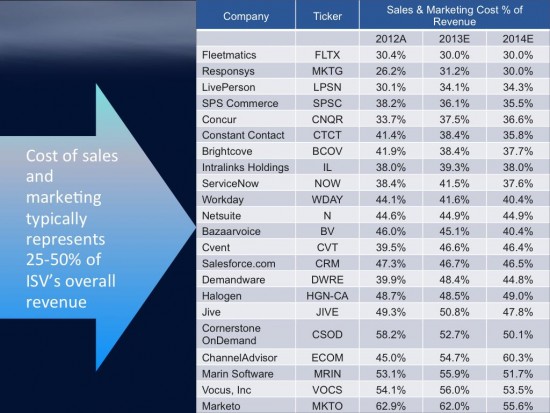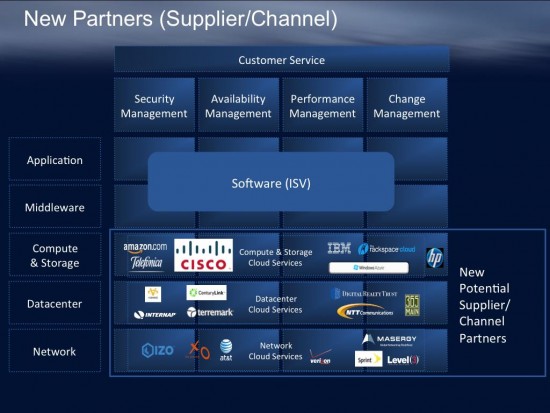In my previous Cisco Blog post, I discussed the business models an ISV can deploy in moving to the Cloud. In this Cisco Blog, I’ll discuss one of the most important parts of any software company’s business model: the cost of sales.
Cost of Sales is Highest Cost for any Software Business
To begin, it’s important to note that the cost of sales is the highest cost as a percentage of revenue for any software company. The figure above shows some examples over the past three years. In some cases, the cost of sales is six times the investment in R&D and in all cases exceeds the cost of operations.
There are plenty of reasons why the cost of R&D is going down (availability of open source, global development resources, higher level functionality) and technology reasons the cost of operations is going down (advent of compute & storage cloud services, increased automation of security, availability and performance management), so looking forward, the cost of sales could go to 60 or 70% of revenue.
So what can be done about this?
If we continue to see sales as human labor and changing comp plans as our main lever to direct a sales force, we’re condemned to higher costs. The implication to this is that average selling prices need to go up, which generally reduces sales velocity. We need to rethink the fundamental principles of enterprise sales and rethink how post-Internet technology can change the economics. This is a much longer conversation, but let me point you to two fundamental ideas.
Selling is Teaching
In 2009 the Corporate Executive Board (now called CEB) began an analysis of 6,000 enterprise/B2B sales reps to discover what made some better than others. In their analysis, every sales rep in the sample fell into one of five distinct profiles. While of course no one person is purely one profile or another, you can think of these profiles as the dominant traits. The five profiles are: Hard Worker, Challenger, Relationship Builder, Lone Wolf and Problem Solver. When they compared the profiles to performance the results were surprising. The Challengers were 10x more productive than the Relationship Builders, the group we think of as the classic enterprise sales person.
So what are these Challengers doing that is so different? These Challengers were fundamentally started by teaching. But teach what?
Teach Insight
So if the best sales people teach, what do they teach? They teach Insight. So what’s Insight? Insight is the gap between where you are today and where you could be. For a moment, let’s leave the world of enterprise sales and consider Martin Luther King. You may not realize it, but the structure of his speeches and Steve Jobs’ speeches were actually identical. They talk about how the world is today and then how it might be, and back and forth this pattern continues.
Dr. King’s “I have a dream speech” is, of course, famous:
“I have a dream that my four little children will one day live in a nation where they will not be judged by the color of their skin, but by the content of their character.”
Now consider if he had only said “I have a dream that my four little children will be judged by the content of their character.” Well everyone would have agreed with him.
How many times have you finished your presentation, walked out of the room and said, I got this one – they all agreed with me (only to discover in the coming weeks the account effectively goes silent). The problem is you needed to teach Insight. Dr. King needed to teach a nation the idea that “children will one day live in a nation where they will not be judged by the color of their skin.” That’s the Insight. That’s what needs to be taught.
Just in case you think this doesn’t have anything to do with enterprise sales consider the early days of salesforce.com. Their logo and fundamental message was “No Software”. Remember this was a company selling CRM software; therefore, shouldn’t they have said their software improves productivity, speeds sales, or increases pipeline visibility? Shouldn’t they have showed the features they had vs. ACT!, Siebel or Microsoft CRM? No. Their genius was they had to get the customer to agree the current way they were buying, installing and managing software was dumb. If they could convince you of that then they could talk about how CRM could help the customer track sales and opportunities. They sold the “Not”.
They sold the Insight, before they sold the product.
New Partners in the Era Cloud – Your Cloud Services Suppliers
The last generation of client server saw the power of partnership. For instance, Oracle, Sun, EMC and Veritas were once referred to as the four horsemen. We should see the same phenomena in the world of application cloud services (ISVs), only this time it will be the compute, storage, datacenter and network cloud service providers who are the new strategic partners in the era of Cloud.
Why? Because every new customer an application cloud service brings onboard translates directly into increased underlying cloud services infrastructure (and increased revenue for the underlying cloud services providers).
Therefore, if the application cloud service providers can teach the compute, storage, datacenter and network cloud service providers the Insights – what enterprise customers should NOT do – which positions using the ISVs’ applications as the logical action the enterprise should do in the near future, then the cloud service providers can also take their enterprise customers to school on behalf of the ISV. And if that happens, everybody benefits.
And for More Information
Visit my books on:
- Cloud Computing: Transformation, where I discuss the topic of ISVs transforming to the cloud in more detail.
- Find my book on Cloud Computing: Fundamentals, where Seven Business Models is discussed in more detail in a TED-sized chapter
Visit my blogs on:
- Traditional ISVs –Transform your Business into the World of Cloud Computing & Seven Ways to Move to the Cloud
- Watch out for my next blog on Security-as-a-feature, where I’ll discuss how and why we need a more sophisticated understanding of what cloud security really means. . Coming out March 30.


CONNECT WITH US